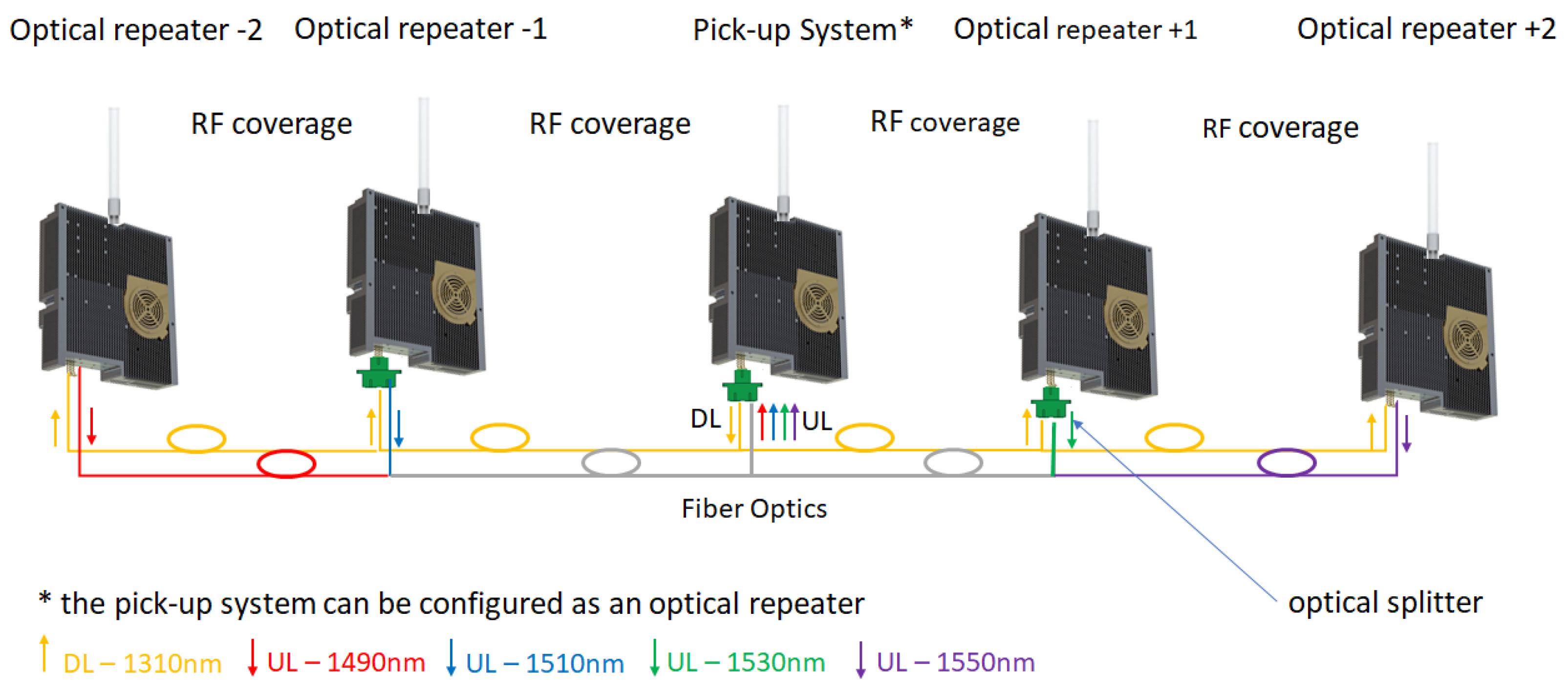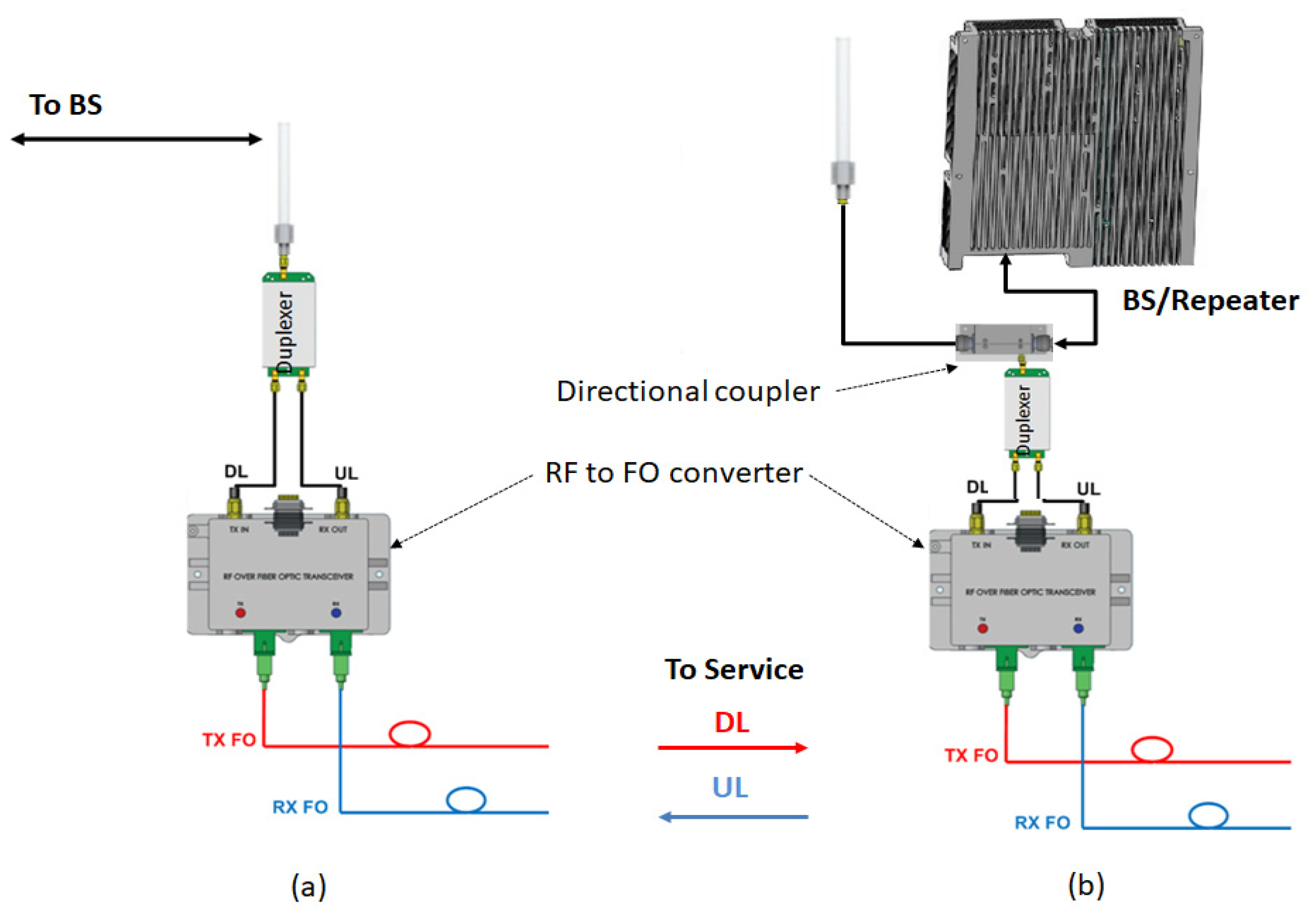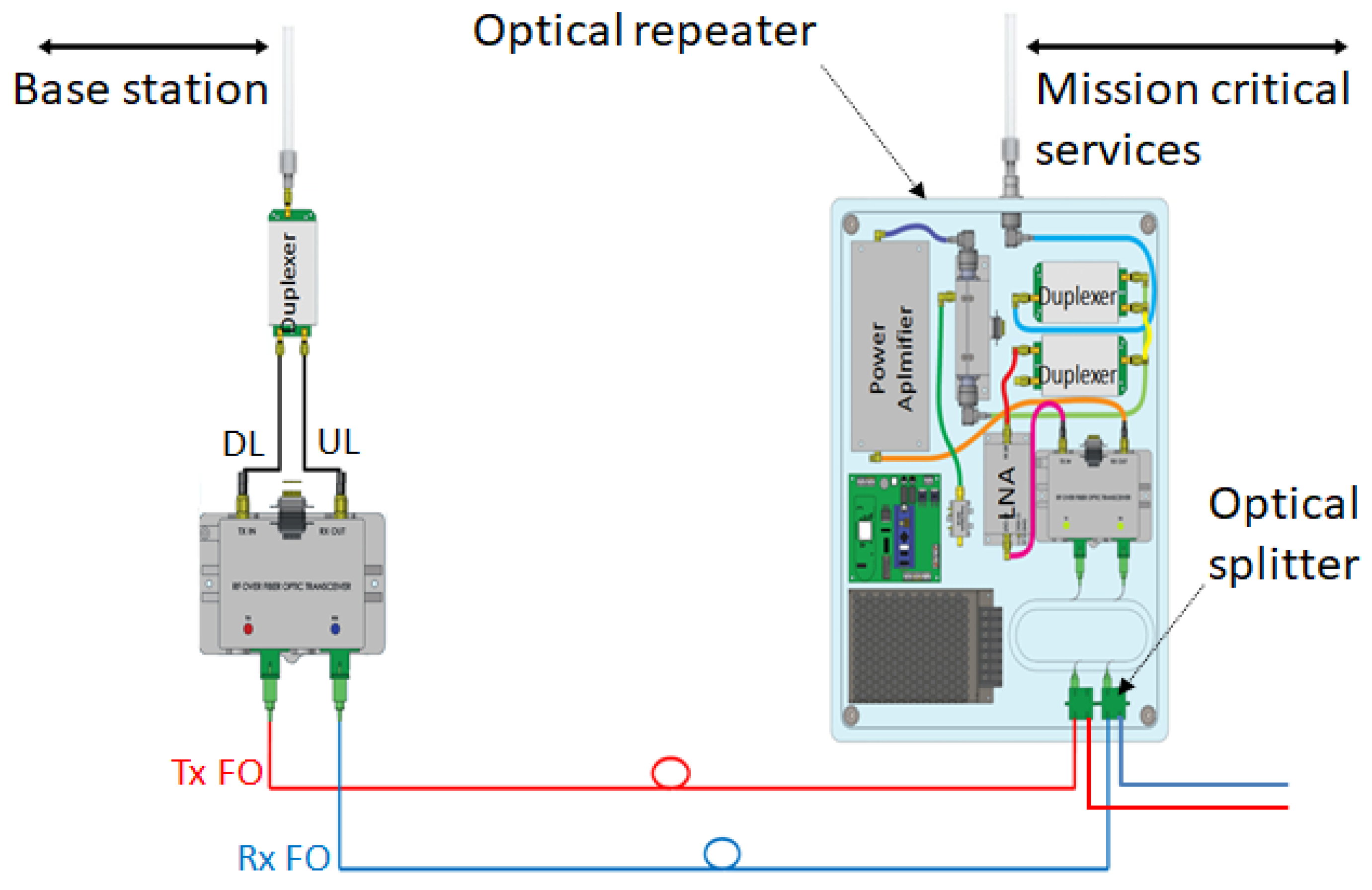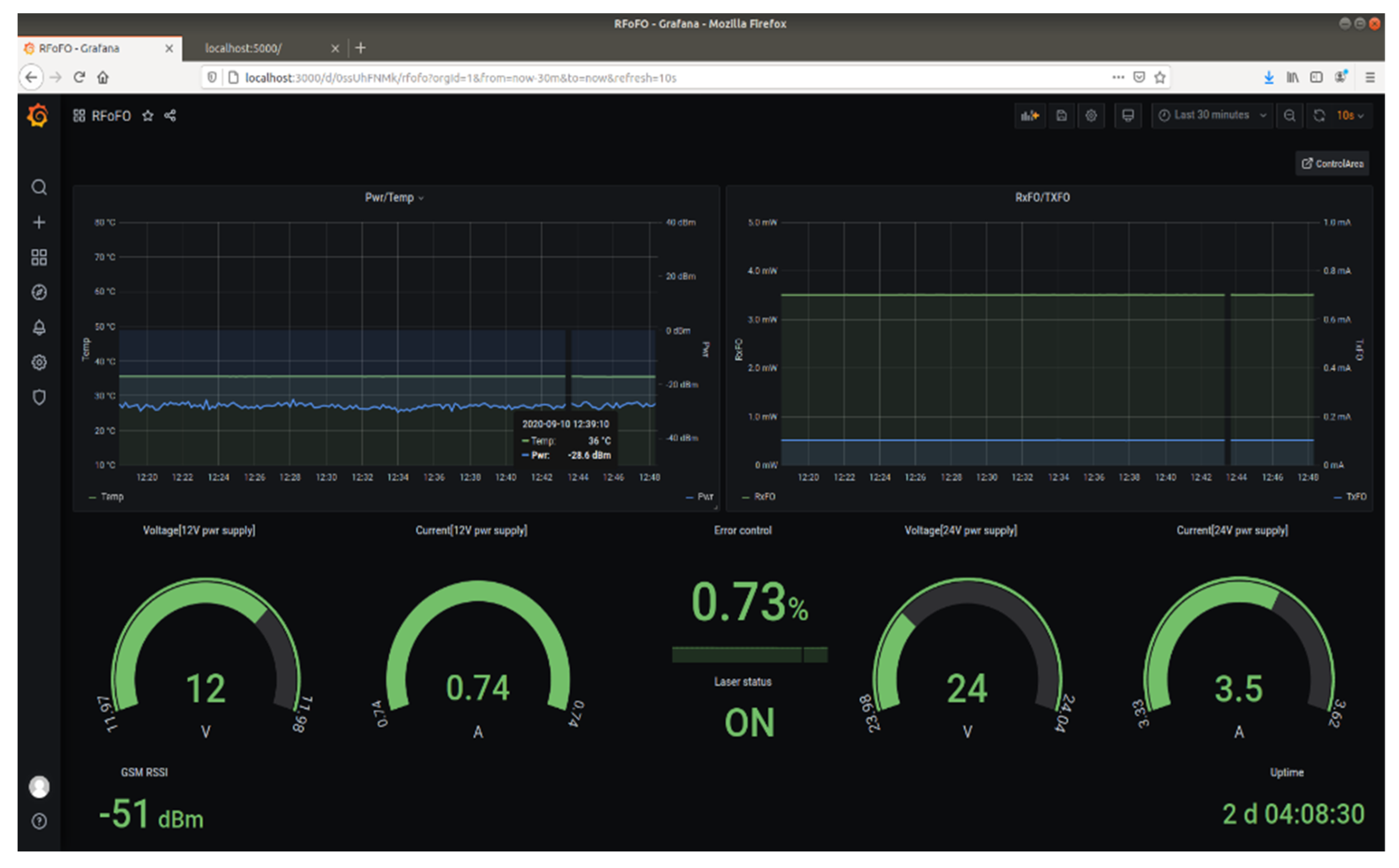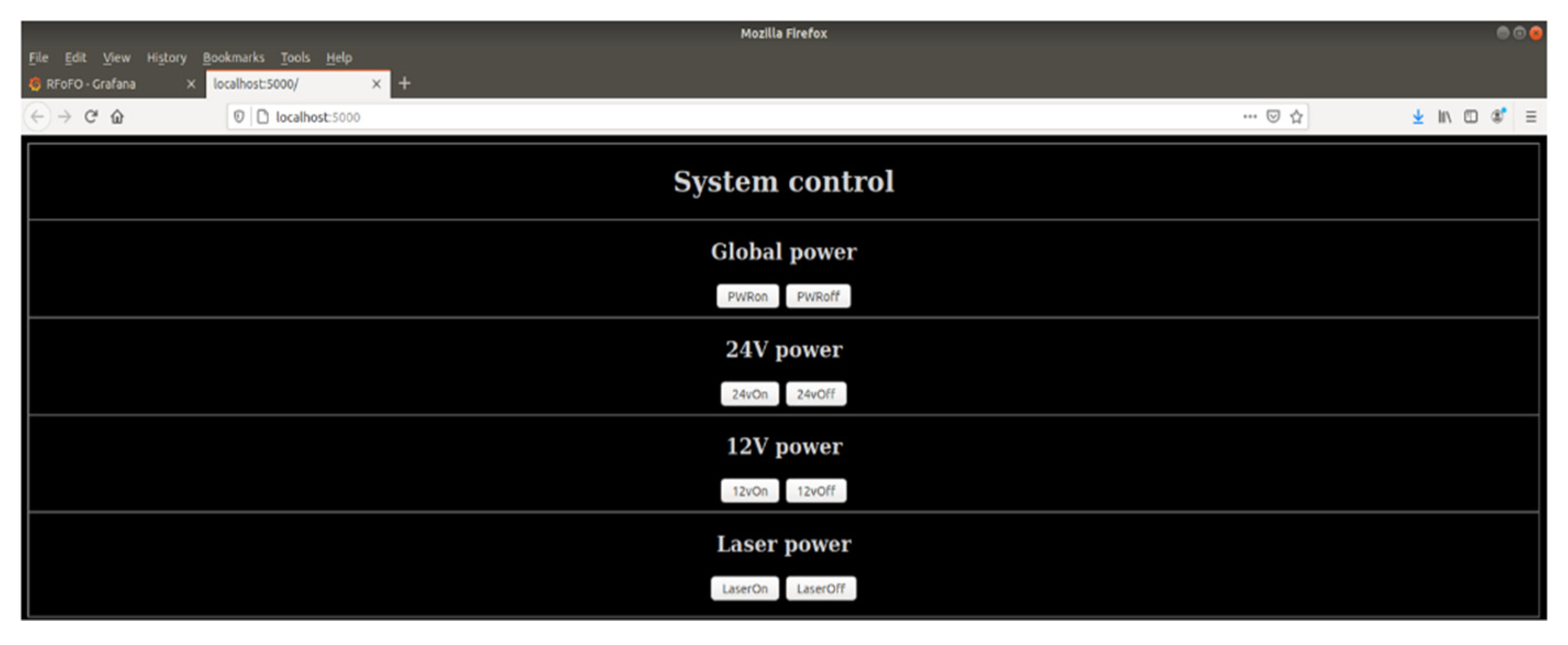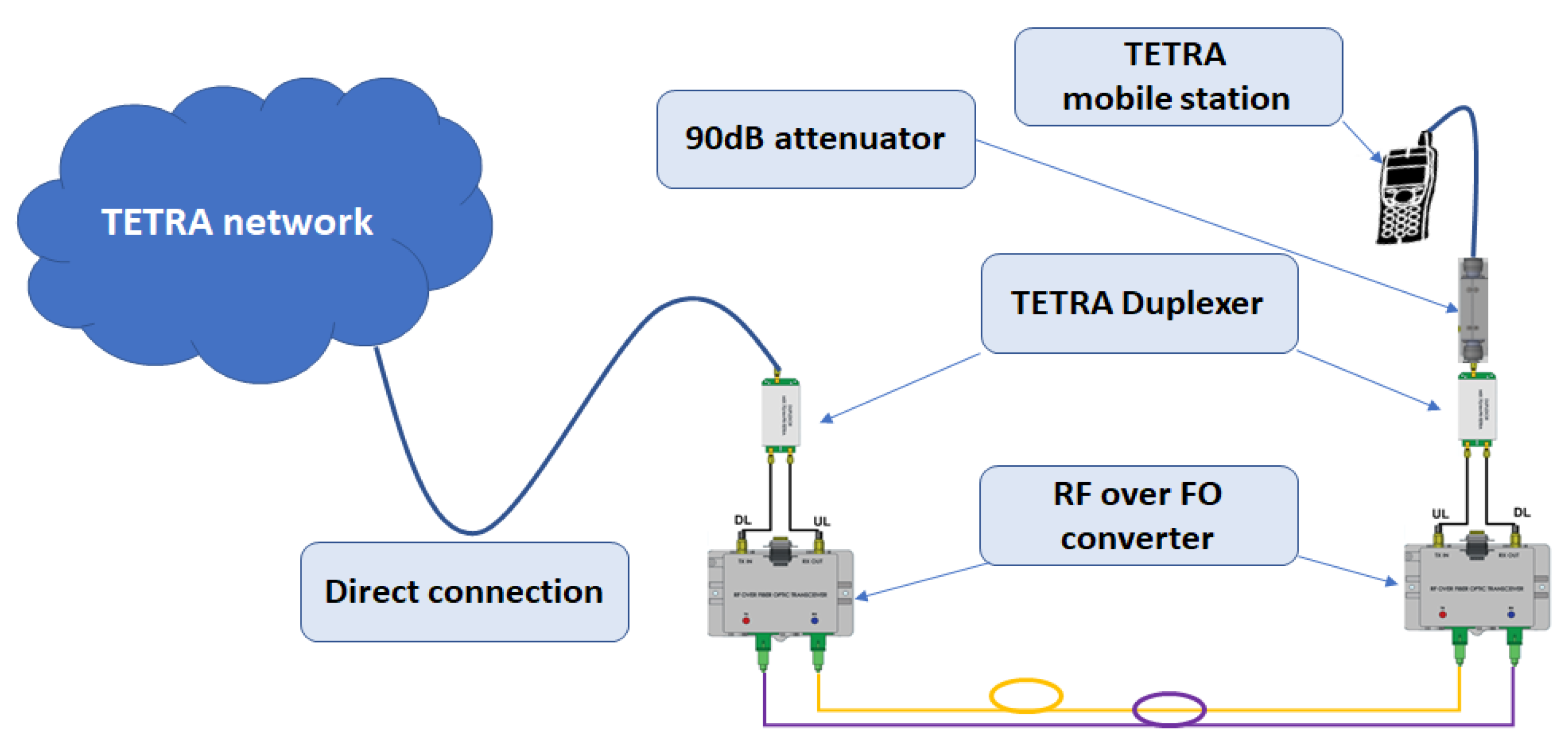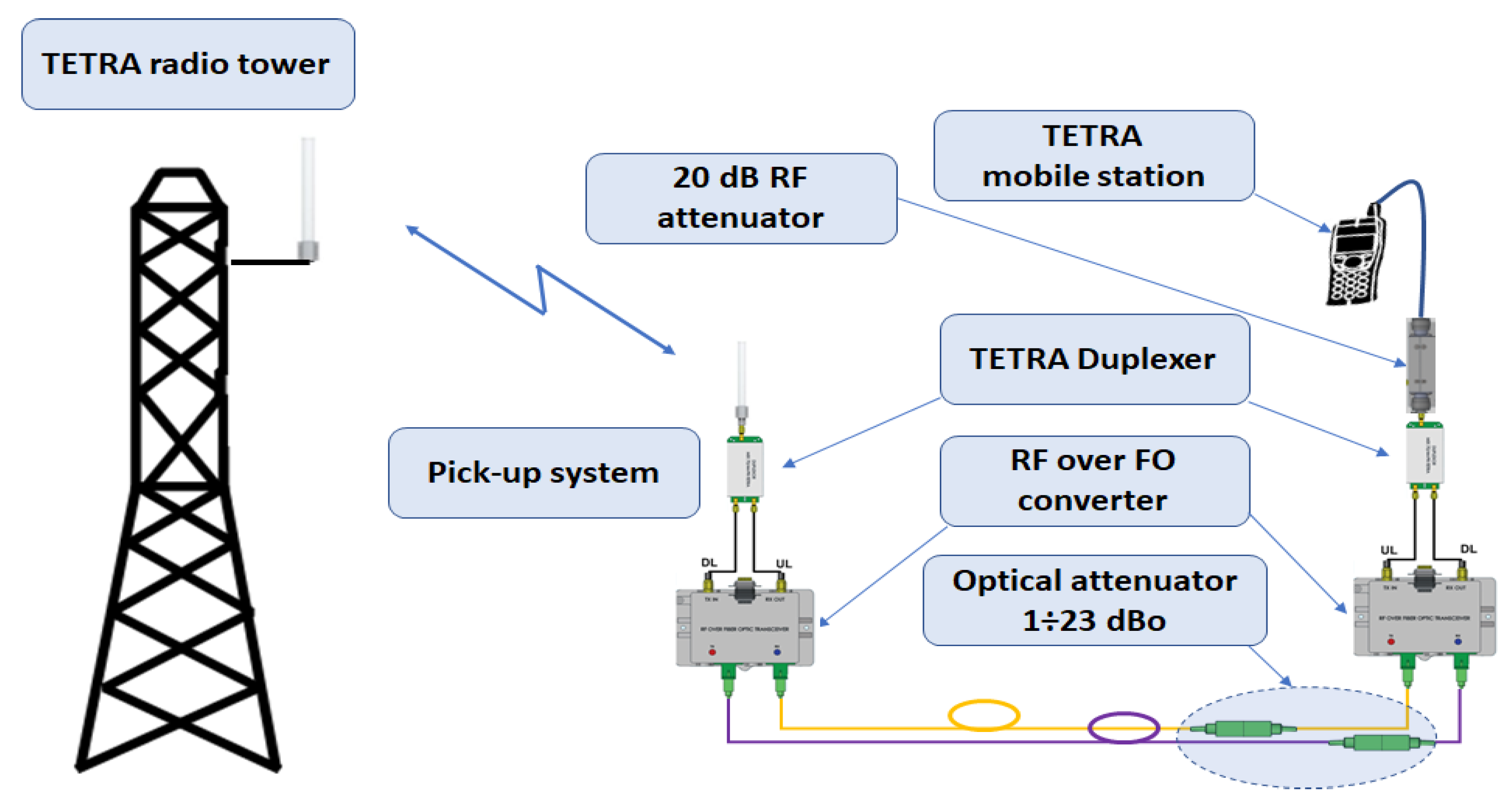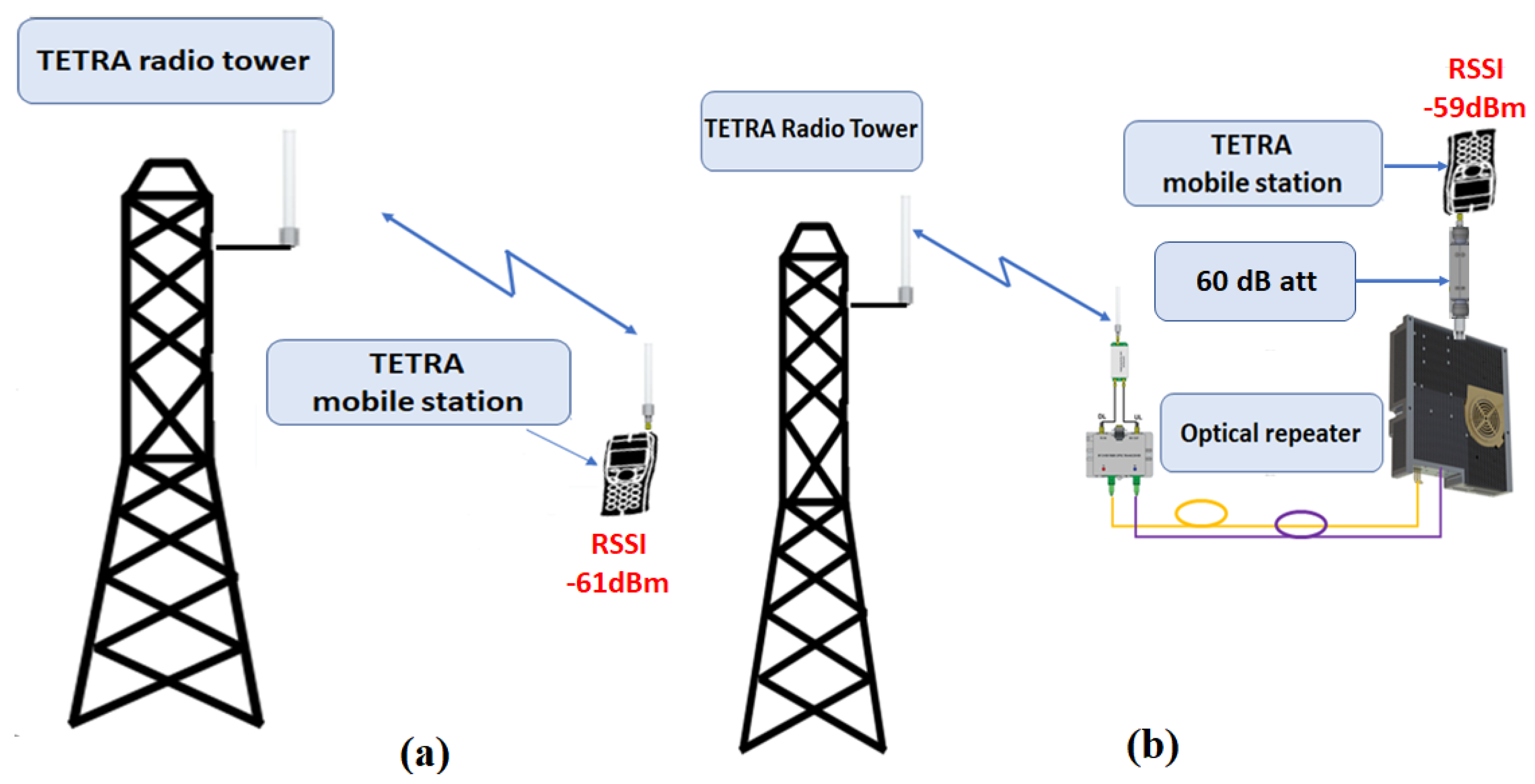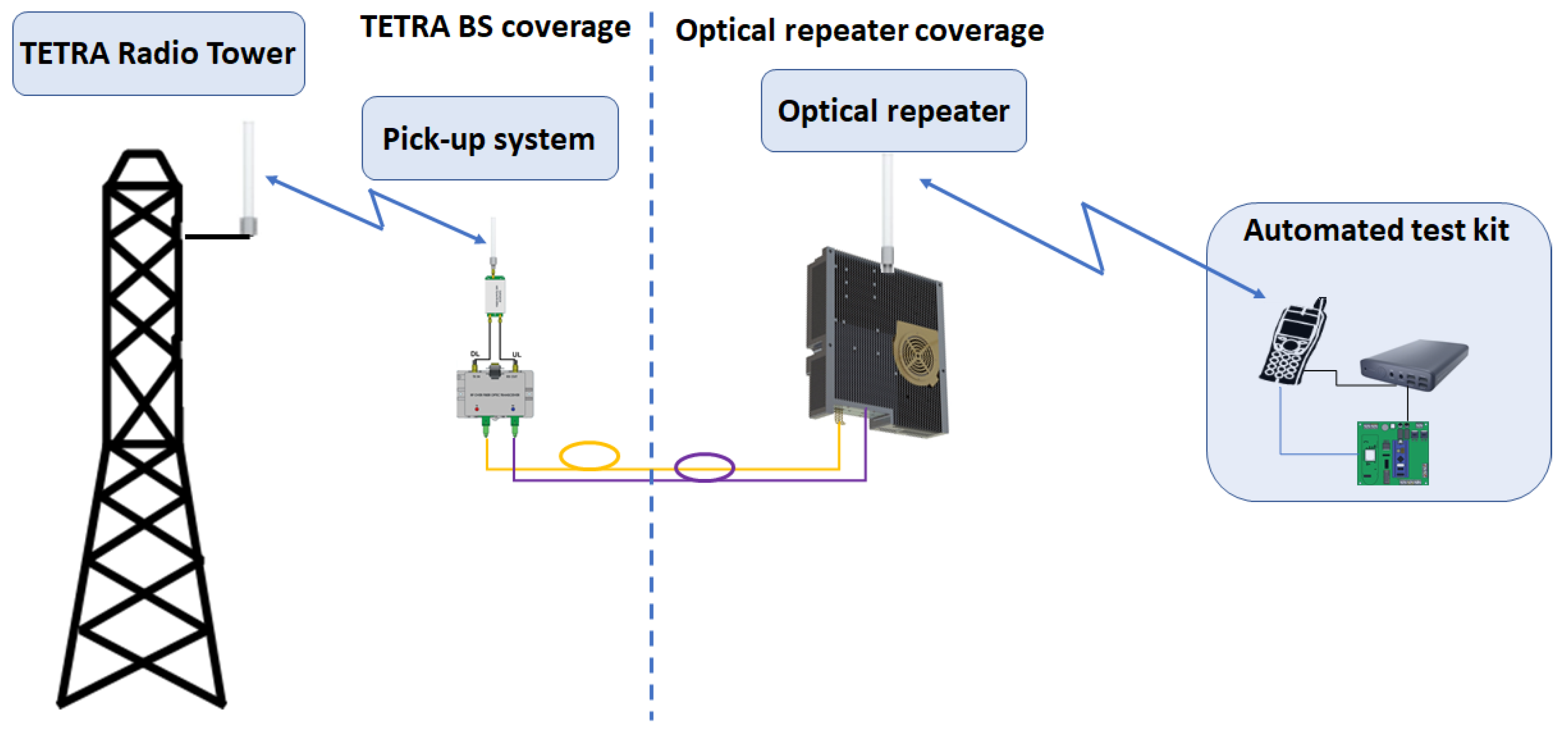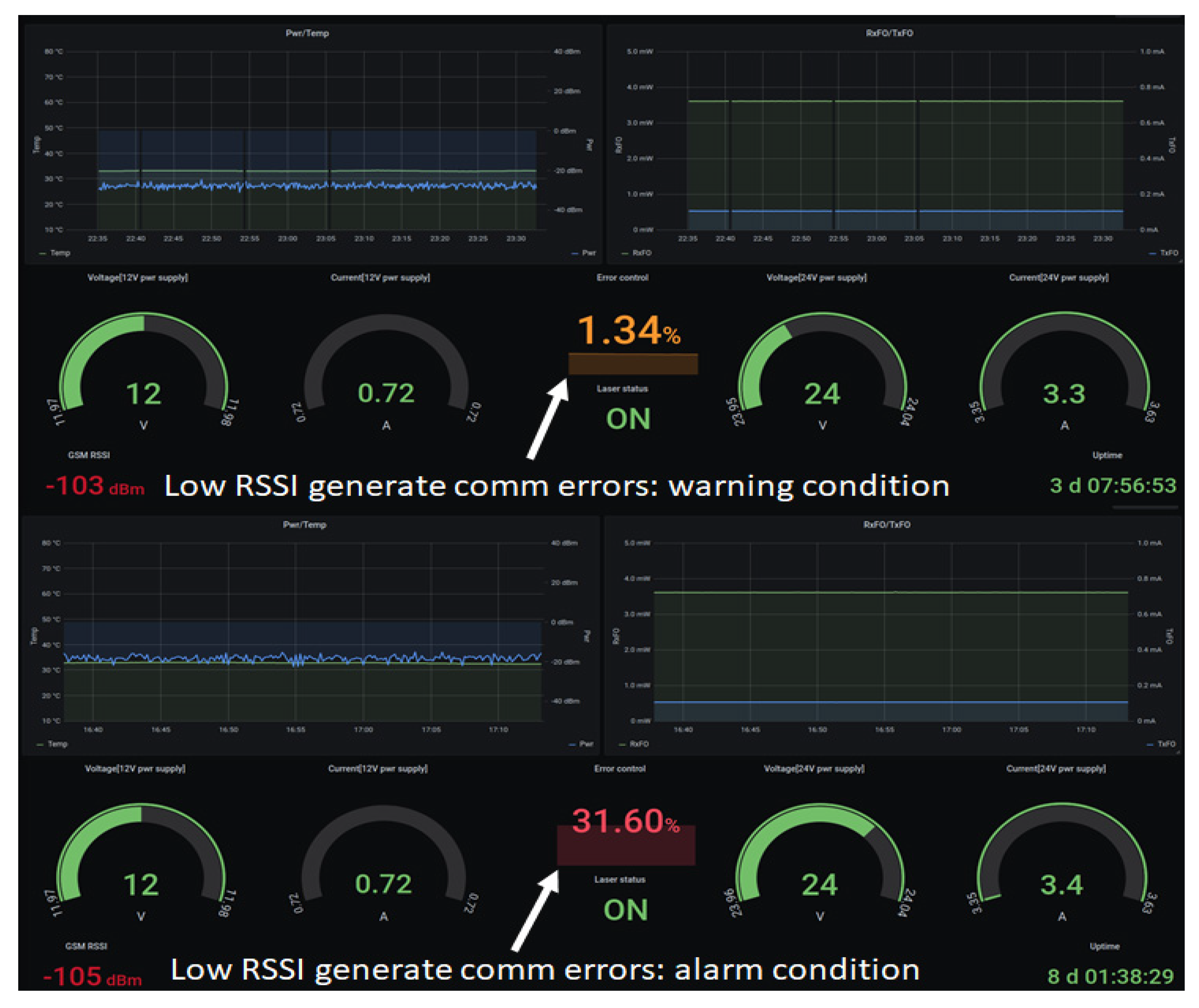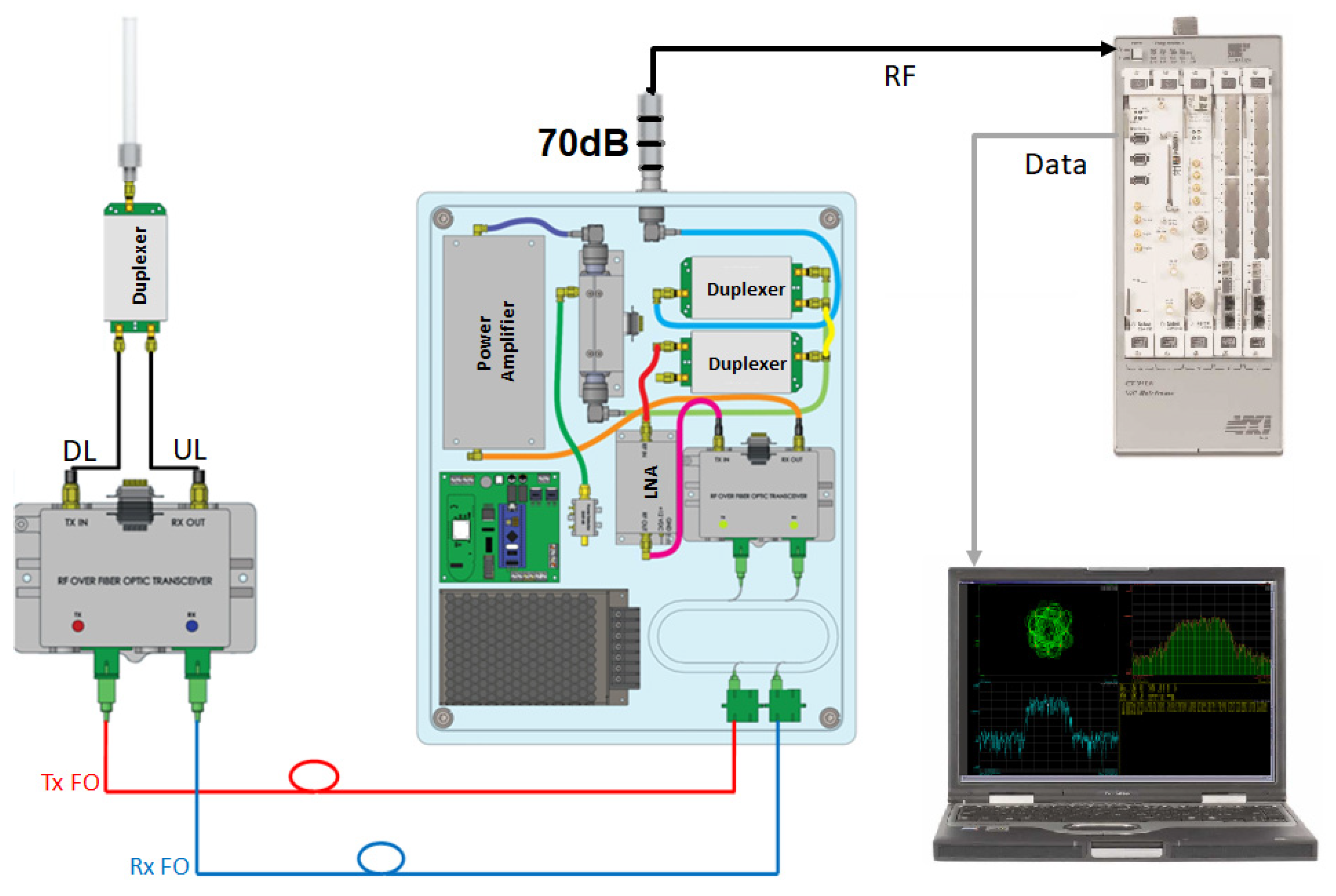1. Introduction
Critical communications can be defined as reliable communications between first responders (e.g., police, fire brigade, medical staff, etc.) during mission scenarios. One key element in assuring the success of the mission is the coordination between all the actors, that can be done by sharing critical information in an effective and uniform way. Mission-critical communications rely on operational mobility which provides a uniform service access and level of reliability for users, regardless of the area in which they operate. Another important aspect is the need for high availability of the communication system. A high availability (e.g., at least 99.99% uptime considered for one year reference, or approximately 5 min of downtime per month) represents a good indicator for reliable critical communications.
The Terrestrial Trunked Radio (TETRA) [
1,
2,
3] is a European professional mobile radio standard, especially designed for military communications, for emergency (police, fire, ambulance) services as well as for transport and public safety networks. The system has numerous advantages, of which we can mention the frequency domain used that allows good geographical coverage with a relatively small number of receivers, thus reducing the costs. The communication is end-to-end encrypted and cannot be interrupted even if the mobile terminals are changing site, making it a very robust and reliable system, due also to the modulation and coding techniques used. When the network is not available, the terminals may enter into direct mode where they are directly connected, ensuring the system functionality in difficult emergency situations, in which most of the networks are failing. On the other hand, there are a number of disadvantages, since it necessitates a linear amplifier in order to meet the strict radio specifications and to coexist with other radio technologies, which makes the handsets more expensive. The transmission rates are also relatively low compared to modern application requirements.
However, due to their important advantages, many research teams have tried to develop and extend the existing system, eventually by combining them with different other standards, in order to increase the coverage area, and to improve the overall system, offering a more flexible and scalable architecture, for specific types of operations. In [
4], the authors analyze the possibility of integration between TETRA and LTE Technology, in order to benefit from the advantages offered by both system advantages for future 5 and 6G systems, while in [
5], the authors present a number of measurement results regarding the co-existence between LTE and TETRA in the same 800 MHz bandwidth in order to optimize their cooperation for critical mission applications. In [
6], the authors analyze the threats and vulnerabilities of VoIP and TETRA systems and compare the countermeasures that have to be taken, focusing on confidentiality, integrity and availability, and in [
7], several measurement results are presented regarding the GPS accuracy and the Short Data Service (SDS) round-trip-time performances of several real-world scenarios using TETRA in trunked mode. In [
8], the authors present several scenarios that enable priority communications (police, border guards, ambulance, fire and rescue) over a commercial mobile network, in order to develop promptly deployable networks for emergency and tactical operations, using prioritization, QoS management, SDN, network slicing, end-to-end security, and spectrum sharing. A heterogeneous solution for ultra-reliable communications is presented in [
9], that includes WLAN, LTE and TETRA, enhanced with automated switching between the wireless technologies through Dynamic Link Exchange Protocol (DLEP) in order to ensure a guaranteed availability for voice connection, additionally providing a supplementary data rate for other additional services, such as video. A disaster-resilient three-layered architecture for Public Safety-LTE is presented in [
10], that consists of an SDN layer that provides centralized control, a UAV cloudlet layer to facilitate edge computing or to enable the emergency communication link, and a radio access layer. Critical content would be served via TETRA while non-critical content would be offered via broadband communications.
The importance and applicability of RF repeaters is stated in several pieces of research. The standardized requirements and technical specifications for TETRA systems are described in [
1,
2,
3] while considerations regarding public safety networks and critical communication systems are mentioned in [
10,
11]. Design and implementation principles for repeaters are found in [
12], where several RF-repeater configurations are presented and analyzed based on numerical analysis and field measurements, and in [
13] a double channel digital repeater is proposed and evaluated that can work at 2.4 GHz frequency in an indoor and outdoor environment. In [
14], the authors present several solutions that can be applied for extending coverage for TETRA networks and the solutions are analyzed based on simulations performed with ICS Telecom. In [
15], the authors present an FPGA-based digital repeater that can be customized in order to be used in different scenarios, frequency bandwidths and numbers of channels, and the results obtained based on the FPGA implementation and its corresponding MATLAB emulator are presented.
The implementation aspects at component level are presented in [
16,
17,
18] and RF over optical fiber (OF) transceiver technical specifications, applicability and limitations are found in [
11,
19]. A review of radio over fiber (RoF) is presented in [
20] with an evaluation of its current use, potential and challenges for future applications. Newer research regarding radio over OF are also presented in [
21], where an optimized digital RoF system is presented for the transmission of LTE 20 MHz signals with 64 QAM modulation; the analytical model developed is presented validated experimentally for 30 km of fiber length. In [
22], the authors present the design of an optimal RoF system and validate it based on OptiSystem software simulation.
In [
23], several radio planning solutions for the TETRA to LTE migration for public protection and disaster relief networks are offered, and their functionality is tested both by simulation and measurements. Testing and validation principles are also presented in [
23,
24,
25,
26]. In [
27], the authors extended the coverage of the narrowband technologies (TETRA, P-25 and Tetrapol) to extend their coverage areas for mission-critical applications using digital mobile radio, and tested their system for the Attica region. The authors of [
28] studied different combinations and configurations of existing communication technologies (narrowband push-to-talk, LTE, 5G new radio and WiFi) to provide a mission-critical system that offers reliable services and extended coverage areas.
The novelty in the study is highlighted on three layers: the operational aspect which allows a fast and flexible installation depending on the scenario requirements, the technical aspect that offers the benefit of tailoring the technical solution regarding the signal pick-up, radio coverage and service quality assurance, and a resilient approach both system monitoring and functional control.
The paper is organized as follows: in
Section 2, the TETRA system characteristics are briefly defined;
Section 3 presents the use case considerations for a sensor-based approach and several design considerations,
Section 4 presents different RF pick-up modes, while
Section 5 details the optical repeater internal architecture and gain considerations. In
Section 6, link budget values are estimated, while
Section 7 describes the remote monitoring and control solution for an optical repeater, as a web-based application for control rooms such as network operation centers that can be easily extended to a solution for an entire network of repeaters. Test and validation measurements are described in
Section 8, considering gain measurement, various services testing, modulation quality measurements and an automated testing procedure from service side.
Section 9 is reserved for result synthesis and discussion. Conclusions and future work are presented in
Section 10.
3. Use Case Applications and Design Consideration for Network Approach
Mission-critical communications, such as voice and data, successfully address public safety and emergency response aspects. As voice communications are well covered by different modes of operation, centralized coordination and grouping features, messaging and data services are also important issues that should be taken into consideration in mission-critical communications. Developing sensor applications in public safety and emergency-response solutions can be of great benefit as TETRA is still one of the most reliable wireless networks with respect to mission-critical communications. Integration of different types of sensors in such applications can be performed by messaging and packet data features correlated to TETRA specifications. An essential feature related to critical communication is prioritization and pre-emption which allows prioritized access to network resources. One example is Short Data Service (SDS), described in
Section 8.4 for one of our test and validation procedures. Sensor data can be encapsulated in SDSs, as shown in
Figure 1 and sent to a control room endpoint or application over TETRA infrastructure. This method benefits from the prioritization due to the SDS best service approach: SDSs are sent on the first slot of the main control channel (MCCH), in contrast to other wireless communication systems that may be using the best-effort approach when dealing with messaging and data. Another method of transporting sensor data is by packet data service (PD), which can establish UDP and TCP communication on TETRA’s traffic channels (TCH).
To conclude, the designed optical repeater along with TETRA mission-critical communications is well suited in applications where public safety and emergency sensors must benefit from network coverage, prioritization and reliable communication.
This work addresses the practical aspects of building an optical repeater, as an experimental research model transitioning to a real-life operational prototype solution that can be integrated in a cluster or network, as shown below. The RF over fiber converter used for TETRA coverage extension has a wide RF bandwidth (from 30 MHz to 2.7 GHz) and is equipped with an internal RF low noise amplifier of 20 dB. It converts the RF signal into an optical signal using a linear distributed feedback (DFB) laser (TxFO) and re-converts the optical signal into RF by a linear photodiode (RxFO). The optical transmitters have different wavelengths in order to reduce the interference for the uplink path (although TETRA uses TDM frames and there is a floor control implemented at BS side, a possible scenario is that the repeater can extend several BSs so the separation is both ways: time and wavelength).
The architecture design for an optical repeater network comprises of one RF pick-up system and one or more optical repeaters distributed either in star or daisy-chain topology. The link between the pick-up system and its optical repeater(s) consists of one or two fiber optics (one in the case of WDM/CWDM and two for separate optical Tx and Rx daisy-chains). Depending on the number of repeaters, one or more wavelengths can be selected for use:
The maximum number of optical repeaters is limited by the optical attenuation between the pick-up system transceiver and the last transceiver from design. The limitation is due to low dynamic range on the optical transceiver side, usually 15 dBo (optical loss dB) mentioned in the provider’s technical specifications. As shown in
Section 8, tests should be made prior installation in order to validate proper functioning at higher attenuation values. Pushing the attenuation limit should be backed up by an error control mechanism implemented in the monitoring and control solution which evaluates at least the optical power received from the corresponding RF over OF convertor.
Besides network side error control, an automated quantitative test should be performed from the service side (e.g., the percentage of successful messages received related to messages transmitted). This procedure involves configuring a mobile station to transmit periodic messages to another mobile station or application. Each message should contain at least the channel frequency, received signal strength indication and a message counter.
An optical repeater for mobile communications uses transceivers from the RF to optical domain in order to transport the signal at the remote site where the reverse conversion is performed. At least a pair of RF over OF transceivers are used, for example in a point-to-point deployment. The maximum distance between the transceivers can be estimated as:
where
is the dynamic range of transceivers considered for the optical link and
is the optical link attenuation including the loss inserted by fiber, patch-panels, connectors, optical distribution frames, splitters, etc. The time delay estimations should also be considered due to the TETRA frame structure which should not exceed the maximum cell radius of TETRA terrestrial cell of 58 km or 193 µs round-trip time, according to [
1,
2].
where
is the time delay corresponding to maximum theoretical cell radius,
is the propagation delay,
is the extended coverage delay and
is repeater processing delay. Different operating scenarios for this design are possible, such as buildings, tunnels and open areas with insufficient or no radio coverage, but also scenarios where there is a need for increased traffic capacity.
6. Link Budget
The calculation was considered from the perspective of antenna and radiating cable as possible installation scenarios. As prerequisites we consider a system that operates at 400 MHz, a base station (BS) with a power of +43 dBm, a pick-up system placed at
d = 1 km from the BS, the free space loss (FSL) is estimated at −84.5 dB and the transmitter and receiver have the antenna gain G
ant = 10.5 dBi. The received signal power at pick-up system was estimated to:
where
The DL power budget at the output of the repeater is:
In order to estimate the coverage distance, we considered a minimum received signal level for a TETRA mobile station of −100 dBm. A radiating cable installation scenario was taken into consideration. The cable performance at 400 MHz is a longitudinal loss (
) of 18.2 dB over 1 km and a coupling loss (
) of 54 dB. The maximum distance is given, then, by:
which yields a distance for the repeater of
.
On the UL path, the mobile station has an output power (
) of +30 dBm. The signal level measured by the base station in this scenario is:
which gives a total value of
−99.9 dBm.
The optical fiber path will introduce additional loss (approximatively 0.8 dB/km RF equivalent) which will reduce the estimated distance accordingly. For a 3.71 km fiber optic path, the corresponding additional attenuation can be estimated at 3 dB.
7. Monitoring and Control Design
The state of the system and control functions are one of the most important elements in designing a mission-critical communication platform. Information regarding the performance of both the platform and individual elements should be continuously sent to the control room for monitoring and decision making.
Connection oriented solutions should also be taken into consideration, such as error control mechanisms, data frame counters and uptime for each controller, confirmations, etc. Redundant communication links, other than the ones monitored, should be implemented and used for this process. The control board should integrate at least two communication links (e.g., an ethernet controller and an GPRS/LTE modem). In this respect, we designed the monitoring and control platform as an IoT solution, based on MQTT standard which uses the publish/subscribe pattern. The board accumulates the sensor data, structures it into JavaScript Object Notation (JSON) format and publishes to the MQTT broker.
The control room is a client that subscribes to the published messages, logs the values (e.g., a NoSQL database) and displays it in a web-based dashboard with graphical and numerical representation.
The monitoring dashboard, presented in
Figure 4, is built as a web application showing a collection of parameters that should be considered for proper operation. The data is periodically displayed and evaluated by querying a database of time-stamped recorded data created for long-term storage.
The monitored parameters are defined as follows:
Pwr/Temp graph: The PA output power (green curve) indicated by the power detector. The value is corrected by 30 dB which is the coupling value of the directional coupler connected to the output of the PA. The temperature (blue curve) is measured by the temperature sensor mounted on the case of the PA. An alert is triggered if the temperature rises above 50 °C and an alarm and shutdown is enforced at 60 °C.
RxFO/TxFO: These are the optical converter parameters that indicate the received optical power (RxFO) and the bias current (TxFO) for a linear mode of operation. In a daisy-chain architecture these parameters indicate not only the local status but also the status of adjacent converters. In the event of a malfunction, the root cause can be determined by assessing RxFO and TxFO.
Voltage and current gauges: The power supply status and consumption for active components. Alarms are also configured for those parameters.
Error control: The controller reports errors in case of communications issues. For example, if data packets are lost or the endpoint is unavailable, the error counter is incremented. An error percentage can be calculated considering the number of errors detected in uptime intervals. An example regarding communication errors is described in
Section 8—Testing and validation.
Laser status: This parameter is Boolean and indicates the state of the converter’s laser.
GSM RSSI: The communication link between each repeater and the broker can be established either on an ethernet interface and routed through a private network or the Internet, or it can use public land mobile networks with GSM access. The received signal strength indicator (RSSI) is a measure of the local GSM signal quality.
Uptime: Offers information regarding the repeater’s functioning interval. It is used for error evaluation and indicates the time interval between successive reset actions.
In the event of a malfunction, an alarm feature has also been provided. The persons in charge of monitoring should be promptly notified regarding any issues that may impact the services allowing them to take appropriate actions. In this respect, the alarm triggers have been defined considering the level thresholds and data connectivity status. As alarm events are highlighted, the user can access the control page from the monitoring dashboard interface.
In order to remotely perform basic functional operations, access to the control web page of the corresponding repeater is granted directly from the monitoring dashboard. The control mechanism is also web-based, allowing back-end actions triggered by HTML POST methods. The control web page is shown in
Figure 5. The user is able to perform basic operations such as:
Resetting the repeater (global power);
Turning on and off the power amplifier’s power supply (24 V power);
Control the 12 V power supply for low noise amplifier, RF to OF converter, power detector (12 V power);
Turning on and off the laser (laser power).
The entire monitoring and control solution is provided as a virtualized solution and optimized as user-friendly. A long term performance evaluation can also be performed, either by live monitoring the dashboard or offline, by analyzing the data stored in the database with custom-developed tools. The method of integrating the short-term and long-term performance can be a useful indicator for the sustainability of the project.
8. Testing and Validation
The testing and validation methodology was inspired by
DRIVER+ Trial Guidance Methodology Handbook TGM [
28] as it provides a comprehensive way for the preparation, execution and evaluation of the project. TGM’s stepped approach offered a better understanding of:
Structuring the processes;
Context and scenario;
Gaps and risks involved in our project, starting from the blueprint and ending with real operational environment;
Defining the key performance indicators used for evaluation as measurable parameters (e.g., errors over time and number of data frames or the number of successful messages received compared to the message counter at the sender’s side);
The result analysis process, including conclusion drawing and decision making.
Several tests have been conducted prior to validating the entire system.
8.1. Radiating Cable Installation Scenario
This scenario was the first validation test which consisted of simulating the path loss for a 2 km path, as described in
Section 6 and Equations (4)–(8). Taking into consideration 90 dB attenuation (54 dB coupling loss and 36 dB longitudinal loss) and a supplementary 4 dB duplexer attenuation, we tested the voice service, having the mobile station directly connected to the attenuator, as shown in
Figure 6.
For a DL pick-up level of −20 dBm, we measured −98 dBm (note that the RF over OF converters are equipped with a 20 dB low noise amplifier on the RF receiving path) on our mobile station, with the voice service successfully validated in group and private calls.
8.2. Optical Fiber Link Maximum Attenuation
The second test is performed on the setup presented in
Figure 7 and provided several interesting results. Even if the manufacturer of RF over OF converters provided a maximum 15 dBo attenuation between two converters, we tested and concluded that the services can be available at 23 dBo optical attenuation, where 1 dBo is considered as 1 dB optical loss. The dBo notation should remove any confusion between optical attenuation and RF attenuation considering that 1 dBo (1 dB optical loss) has a corresponding 2 dB of RF loss due to the opto-electric conversion. This result can be a good opportunity for inserting two more optical receivers increasing the number of optical receivers and covering areas from 5 to 7 (see
Figure 1).
The sensitivity threshold was determined by increasing the optical attenuation by a step of 1 dBo up to the limit where the mobile station disconnected from the network. The test was performed four times in order validate the 23 dBo limit. The difference of 8 dBo offers the possibility to add another optical repeater on both sides of the branches. The 20 dB RF attenuator which was inserted in order to protect the RF over OF converter’s LNA from overload can also be substituted with a supplementary 10 dBo optical attenuation, resulting in a theoretical 33 dBo maximum attenuation for the optical link. Note that a high attenuation on optical link, produces a low RF output power on the service side, which in some scenarios can become an impractical approach for a wide coverage area deployment, but still practical in small areas such as small or open-area offices. The reason we should leverage the capabilities of this solution and increase the number of optical repeaters in the deployment is based on cost efficiency and can be justified as follows: suppose the installation scenario is by direct coupling to a BS. RF pick-up power is high enough to insert another optical repeater at the end of both branches and benefit from supplementary TETRA coverage in an underground parking lot and a small building. With proper link budget calculations, on-site measurements and optical and RF power monitoring, service interruption will be minimized to an acceptable risk. Another example may be an underground metro network. In this deployment, the pick-up may also be performed by direct coupling to one or many BSs, depending on the metro underground architecture. The goal is to invest in a minimum number of BSs and a maximum number of optical repeaters that will be installed in underground stations.
8.3. Measurement of the Effective Gain
The effective gain of the repeater for the DL path was evaluated by measuring the RSSI indicated by the mobile station and applying a substitution method. The reference measurement of the RSSI was taken by connecting the pick-up antenna directly to the mobile station, as shown in
Figure 8a, resulting in an RSSI of −61 dBm. Then, by using the testbed according to
Figure 8b, we obtained −59 dBm, which concluded an effective gain of 65 dB, according to Equation (8). We took all necessary measures that the same BS was serving the mobile station in both scenarios.
The measured DL gain is:
where
is the power measured by the mobile station at the repeater output,
is the power measured by the mobile station at pick-up antenna,
is the attenuation inserted at output port of the repeater
is the attenuation inserted by the duplexer (typ. 2 dB) and
is the supplementary attenuation (at least 1 dB) inserted by RF cables, OF patch and connections.
Further testing was executed by configuring a testbed according to
Figure 3 and
Figure 9. The procedure was performed in a pass/fail manner and it consisted of:
Measurement of DL gain over the carrier,
Figure 8 and Equation (8);
Power and temperature over time,
Figure 4;
Measurement of optical received power;
Group call in trunked mode of operation (TMO);
Private call over TMO and PSTN;
Automated messaging in a 24-hour trial,
Figure 9;
Control settings.
8.4. Service-Side Testing
This test was performed in order to obtain an indicator regarding the continuity of providing services over a given period of time. For voice services, several tests were successfully performed, but voice service testing is impractical over a large interval (e.g., 24 hours of continuous testing). Thus, an automated testing procedure is needed for this case. In this respect, we developed a system comprising a mobile station, a power-bank, and a single board computer (SBC), as described in
Figure 9.
By periodically sending status messages from the automated test kit, we were able to make both quantitative and qualitative evaluations.
We used Python scripting in order to access the serial interface of the mobile station and send AT commands to extract the RSSI and other parameters reported by the mobile station, according to
Figure 10. The above information alongside a message counter was coded in a Short Data Service (SDS) message and transmitted at intervals of one minute to a receiving party that counted received messages, as shown in
Figure 10.
After a session of 18 hours, we successfully received 98% of transmitted messages. SDS has also several other important implementations such as telemetry, database query and automatic resource location applications.
The code presented in Algorithm 1 consists of a loop that executes a series of procedures. By creating a serial communication object, we were able to connect to the mobile station, send AT commands and receive responses. The data received was parsed using a lookup table method and the measured RSSI was logged. Next, we constructed the SDS message that the mobile station should send over the TETRA network using the previously RSSI value and a message counter. After sending the SDS message, we logged the data consisting of current message index and RSSI in a text file stored in the memory of our SBC that we also used for controlling the mobile station.
During the interval that elapsed between the initiation and the end of our automated test, we successfully received 1085 out of 1103 messages. Although further improvement of the Python code related to timing and serial control could have improved the 98% success, we considered this test as a PASS.
| Algorithm 1. Serial connection, RSSI request, message construction and logfile update. |
Input: serial object while continuous loop until exception or program interruption do Serial connection to mobile station RRSI request Response read and parse result in variable (result) Close serial connection if result is not valid then Exception handling else (program continuation) Conversion of result according to a RSSI lookup table Increment the message counter (msg_count++) SDS message construction (contains result and msg_count) Serial connection to mobile station Send SDS message to the destination Close serial connection Write content of SDS message in local logfile end end
|
Content of the log file consisting of the last measured RSSI and the message count is marked in
Figure 10.
The use of a programable automatic test kit as an acquisition system represents a practical and efficient method not only for service side testing, but also for different applications such as: environmental monitoring (e.g., temperature, humidity, gas leakage, etc.), conditional triggering (access control, power supply control, etc.). The reliability offered by the TETRA network and the autonomy provided by a high-capacity power bank makes the automatic test kit a proper solution (primary or secondary) for a redundant monitoring architecture.
This benchmarking solution opens the road for future research in the form of a compact portable system supplemented with location information that can be used for mobile georeferenced measurements of network coverage and automated service testing. For example, automated testing of voice quality can be integrated in this benchmarking solution by implementing a test procedure similar to perceptual evaluation of speech quality (PESQ), which is a result of ITU-T efforts to standardize the end-to-end speech quality of narrow-band telephone networks and speech codec [
37].
8.5. Monitoring and Control
The testing and validation stages for monitoring and controlling technical solutions were performed in order to identify the availability thresholds and performances of our optical repeater. First method was to obtain the correct values that are logged in the database. These values were obtained from sampling the analogue signals provided by the sensors and converting the voltage values provided by board’s ADC to corresponding units (e.g., temperature °C, power dBm, etc.), either by a linear formula or by the means of a lookup table, for non-linear conversions. Queried results from database are shown in
Figure 11:
GSM RSSI—received signal strength indicator for local GSM service;
PDIPV—power detector, ADC reading (volts);
PDIPDMB—power detector, measured power (dBm);
TEMP1—power amplifier, measured temperature (°C);
ERR—control board, error counter;
FRM—control board, data frame counter;
UPT—control board, uptime.
In order to monitor the functional stability and the performance of the system, we considered three parameters (ERR, FRM, UPT), which can be used as quality indicators for error control mechanism (e.g., number of errors over uptime or over the number of data frames).
Validation tests were performed in areas with low GSM RSSI, where the number of communication errors increased dramatically, from a warning state (e.g., 1.34%) to an alarm state (e.g., 31.6%) considering the number of errors in relation to uptime, as shown in
Figure 12. Being designed as a connection-oriented monitoring solution, the dashboard reports low GSM RSSI measured by the GSM modem which correlates with the error control parameter indicating a communication issue that may impact accessing the status information and limit the control function. Although a percentage of 1.34% communication errors can be accepted considering a low RSSI of −103 dBm, a decrease of only 2 dB to −105 dBm definitely is not acceptable, as the error control increases to a value of 31.6%, indicating that the repeater is close to being isolated from the monitoring network, as indicated in
Figure 12. Please note that TETRA services were not influenced by low SNR conditions for GSM communication, but only the monitoring and control solution. In such cases, redundancy, for example, a supplementary connection over ethernet, should be implemented as a second communication link for monitoring and controlling continuity assurance. The separation between services and control media is an important aspect that should be taken into consideration from the design stage, as it should not represent a single point of failure. For example, if the communication link for control and monitoring solutions is lost, services should not be affected. The same statement applies if the service is lost: the control and monitoring applications should be able to indicate an alarm.
An important element to mention is that testing and validation was performed in a bidirectional way:
Network to mobile stations: RF coverage distribution, link budget calculation, gain considerations, monitored parameters, control mechanism and service-side testing;
Mobile stations to network: service-side testing using the automated test kit for SDS service and voice services tests;
The reason for this approach was to gain confidence in the solution by correlating the information provided by our monitoring and control solution with an independent one (e.g., a system that measures the RSSI and counts sent messages).
8.6. Quality Measurements
This evaluation was performed using an Agilent (Keysight) Vector Signal Analyzer in order to determine the influence of the active stages over the digital modulation (
). The testbed for quality measurements is presented in
Figure 13.
In order to perform the modulation quality check, one can observe on the IQ diagram a feature of the vector signal analyzer, as shown in
Figure 14. The IQ diagram is a representation of IQ baseband signal in time domain as transitioning from one symbol to another.
The
modulation used in TETRA encodes the data bits in the phase change between consecutive symbols, resulting in eight symbol positions and two bits per symbol, as shown in
Table 2 and
Figure 14:
Table 2.
Bit values related to phase change.
Table 2.
Bit values related to phase change.
| Id | Bit Values | Phase Change |
|---|
| 1. | 00 | |
| 2. | 01 | |
| 3. | 10 | |
| 4. | 11 | |
In an ideal transmission, all symbols corresponding to each ideal state in the diagram should overlap. The real scenario, though, will produce a dispersion around the ideal points. The vector signal analyzer implements the quality limits imposed by the standards [
1,
2,
3] by defining an error circle around each ideal point. The distribution of detected symbols with respect to the error circle offered a fast and comprehensive indication regarding the quality of the service provided by our optical repeater, as shown in
Figure 14 and
Figure 15.
The first conclusion reached is that the symbol distribution is grouped inside the reference circle, with no visible influence from interferences, phase noise or added noise, as shown in
Figure 14.
The next quality evaluation was to perform multiple measurements over error vector magnitude (EVM) and logging the worst and the best results, according to
Figure 15 and
Table 3.
EVM and spectrum measurements represent good practice, not only in the laboratory but also in a real operational environment, as they may reveal equipment malfunction or electromagnetic interferences that may produce an interruption of services.
The parameters presented in
Table 3 represent an in-depth assessment regarding the signal quality and are defined as follows [
38,
39]:
EVM—obtained by determining the error vector which represents the difference vector from the ideal and measured symbol positions. The higher the EVM, the greater the displacement from the ideal state, as shown in
Figure 15.
MagErr—The IQ magnitude error represents the difference in amplitude between the ideal and the measured state.
PhaseErr—The IQ phase error represents the phase difference between the ideal and the measured state with respect to detected symbols.
FreqErr—The error of the instantaneous frequency of the measured signal compared to the reference, relative to the detected symbols.
IQ Offset—Reflects the deviation of the real IQ diagram from the reference. The IQ offset is generally produced by the carrier feedthrough introducing a DC offset to I and Q data. A high IQ offset may affect the receiver’s ability to correctly detect the symbol.
Quad Error—a measure of distortion and reflects the deviation from the ideal 90 degrees between I and Q components.
Amplitude droop—Represents the power decrease of the transmitted signal relative to the symbol.
Gain imbalance—Evaluated in a predefined measurement interval, the gain imbalance is determined as a logarithmic ratio between the magnitudes of the I and Q components.
With the worst EVM values of 2.91% and best 1.84% (5% being considered a quality threshold) according to [
1], we concluded that the modulation quality is not affected by our design implementation. The conclusion was also validated by IQ diagram analysis and practical tests performed as voice calls and SDS messaging.
9. Results and Discussion
Designing an optical repeater, conducting tests and integrating the results in an experimental network is a real challenge when one aims for performance, reliability, availability and scalability at the same time. Either we deploy a single optical repeater or several repeaters that form a cluster or even an entire network, the technical solution should be integrated seamlessly in corresponding radio communication systems, according to purpose.
Various deployment scenarios and pick-up modes described in
Section 3 and
Section 4 offer the benefit of flexibility in installation and operation. For example, in each deployment scenario there are always two pick-up modes available: by antenna or via direct connection to the base station or another repeater. While the former mode can be performed at any site with the disadvantage of receiving a low RF signal depending on the distance to the base station/repeater, the latter is not signal restrictive, but the pick-up system should be installed in the same site. On the optical repeater side, the gain was determined for both paths, resulting in 52.6 dB for DL and 65.6 dB for UL considering the 20 dB gain offered by the pick-up system on the UL path.
Link budget evaluation was performed, as described in
Section 6, and a radiating cable (leaky feeder) installation scenario was considered. The results indicated that a length of up to 3.71 km of radiating cable is feasible for a proper communication.
The monitoring of the state of the optical repeaters and function control are described in
Section 7 and shown in
Figure 4 and
Figure 5 for normal operation conditions. In order to validate the solution, a series of tests were executed, as described in
Section 8. A 2 km length, radiating-cable scenario was simulated, as described in
Section 8.1 and
Figure 6. The test was successful, as we could initiate and receive calls on our mobile station. The sensitivity threshold of a pair of RF over OF converters with respect to TETRA services was determined, as described in
Section 8.2. The result was that we could exceed the 15 dBo limit provided by the manufacturer by 8 dBo without degrading the TETRA services. We concluded that an extension by one optical repeater could be possible with the cost of reduced RF coverage. However, in an operational scenario, care should be taken in designing the system due to the fact that, besides the attenuation, another limitation is introduced by chromatic dispersion which produces different propagation speeds for different wavelengths. Limiting the transmission distance, chromatic dispersion represents the differential delay (measured in ps) for a wavelength with a width of 1 ns that propagates through a fiber of 1 km length. For a conventional fiber (e.g., G.652D) [
40,
41] the chromatic dispersion coefficient for a 1310 nm wavelength is negligible but for 1550 nm is 17 ps/(nm×km). High speed transmissions, especially those using dense wavelength division multiplexing technology, are the most affected by chromatic dispersion and need compensation. For example, a transmission of 10 Gbps on a G.652D fiber at a wavelength of 1550 nm will be limited at 61 km, while an upgrade to 40 Gbps will reduce the distance below 4 km without compensation measures.
As a measure of usability, a service-side test validated the solution with 98% success, as described in
Section 8.4. Several improvement possibilities can be explored.
Availability and performance tests for the communication link were executed and results were described in
Section 8.5. Low RSSI for mobile data connection can produce a warning state or an alarm state. This limitation was considered starting with the design phase by using a redundant link as a second communication solution.
Quality was tested by voice calls, messages and by measuring the modulation parameters as described in
Section 8.6. The results confirmed that the prototype does not degrade the quality.
Besides the benefits and advantages brought by the proposed solution, there are also some drawbacks and limitations generally found in repeater deployment solutions. For example, although an extension of the radio coverage is obtained, the capacity is not improved as the serving base station will have to manage an increased number of users. A solution to this issue could be repeating more than one base station. Another limitation is enforced by the daisy-chain topology which limits the number of optical repeaters due to the optical splitters needed in the chain. For example, a four-repeater chain will need three optical splitters that, if carefully chosen (in sequence of unbalanced balanced splitters), will introduce a minimum 6.4 dBo supplementary attenuation on the optical link (12.8 dB equivalent RF attenuation). Another drawback example can be considered in the use of two optical fibers, one for the downlink and another for the uplink path. This choice can be considered resource-intensive in deployments where fiber availability is an issue. An alternative might be to multiplex on a single fiber both the downlink and uplink using devices such as optical add-drop multiplexers, filters, directional couplers or optical circulators and evaluating the effect that any supplementary attenuation introduced by these elements may have on radio coverage and TETRA services. The proposed solution offers this possibility by externally coupling these optical elements at each repeater site.
10. Conclusions
The subject of this project represents a technical challenge as it is meant to provide large-scale radio coverage over various topologies in a distributed functionality.
However, optical repeater design for critical communications is a proper technical solution that provides extended radio frequency coverage considering various numbers of operational requirements. It also can sustain all the aforementioned scenarios related to coverage requirements, signal pick-up, selectivity and applications. Besides functional testing and evaluation, the service quality is targeted, as it is a key aspect in user acceptance. Any service degradation should be prompted by the monitoring and control application that also has a mechanism of root cause analysis. For example, in the cluster architecture presented in
Figure 1, where optical repeaters are installed in different geographic locations, the optical link is monitored in a bidirectional manner: laser power received from the neighbor optical repeater (RxFO) and the laser bias current (TxFO) to the next optical repeater in the chain. Monitoring both parameters allow the identification of the faulty source. Another example is the output RF power parameter evaluation. A low value may indicate a local power amplifier fault, but if the neighbor optical repeater also indicates low values than the root cause analysis may lead to the pick-up system and further, to the base station.
The monitoring and control applications can be operated in a centralized and hierarchized way, starting from component, repeater, cluster and ending with an entire network of repeaters. The flexibility of deployment is one of the most important characteristics as it allows a cost-effective solution to be planned and deployed, starting from a simple point-to-point topology and ending with a multi-clustered network. Another important element is the pick-up mode selection as it offers various solutions to classic issues such as: costs of deployment, low pick-up power level, long distance to service areas, coverage in the pick-up site. An innovative characteristic besides the flexibility of the deployment can be considered the ability to perform signal pick-up and TETRA coverage in the same site at a low cost and optical link attenuation. Another novel idea is the testing and validation automation that can be extended to various types of applications.
Mission-critical services are operated in a seamless manner having the same prioritization and security measures provided by the network. Allowing a versatile installation and assuring extended coverage for different scenarios, the solution proposed in this paper improves the operational mobility and service usability responding to various mission-critical objectives.
Future work consists of implementing redundancy at service level in order to obtain high availability and developing optical repeater solutions for mission-critical communications on other wireless networks, based on the same principles and know-how.
